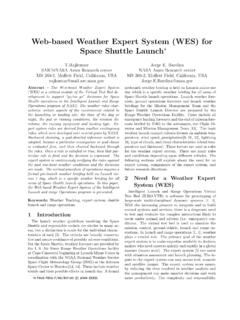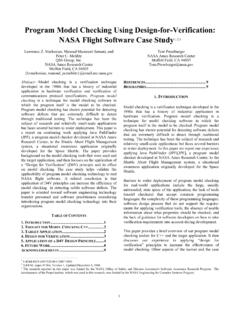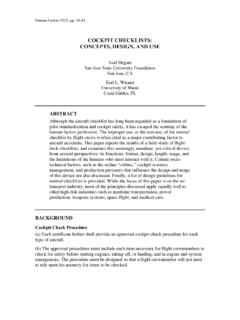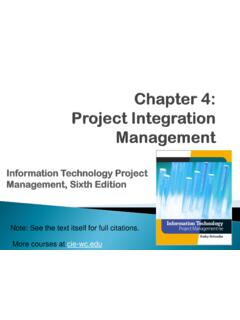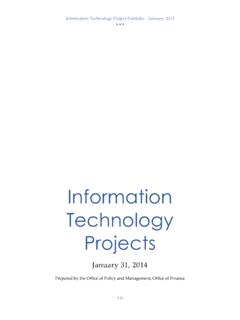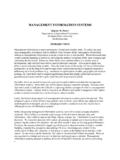Transcription of Information Technology Strategic Research (ITSR) …
1 project PlanMission and Science Measurement Technology (MSM) ThemeNASA Computing, Information , and Communications Technology (CICT)ProgramInformation Technology Strategic Research (ITSR) ProjectCICT Approved:Eugene L. Tu, CICT Program ManagerDateARC Confirms:G. Scott Hubbard, ARC DirectorDateITSR Submitted:David Alfano, ITSR project ManagerDateInformation Technology Strategic Research (ITSR) project MANAGEMENT project SUB- project SELECTION AND MATURATION AND BREAKDOWN SYSTEMS (ES).. AND AND AND SOFTWARE ENGINEERING TECHNOLOGIES (ASET).. Research IN DEPENDABLE METHODS FOR REQUIREMENTS/DESIGN SOFTWARE CONTROLS AND DIAGNOSTICS (ICD) AND NEUROELECTRIC MACHINECONTROL (NEMC).
2 HEALTH AND SAFETY MONITORING (IHASM).. CONTROLS AND DIAGNOSTICS FOR PROPULSION SYSTEMS (ICDPS).. FLIGHT CONTROL (IFC).. AUTOMATION (IA).. MACHINE CONTROL (NEMC).. COMPUTING ALGORITHMS (RCA).. APPROACHES TO (BN).. FOR ELECTRONICS AND AND ANALYSIS OF AT THE DIAGNOSTIC SENSORS AND STRATEGY AND PERFORMING MITIGATION ADVOCACY & TO OTHER PROGRAMS AND/OR OPPORTUNITIES AND Technology AND A: B: CHANGE document is the project Plan for the NASA Computing, Information , and CommunicationsTechnology (CICT) Program s Information Technology Strategic Research (ITSR) project .
3 TheProject described in this document will provide high-leverage, crosscutting Technology solutionsfor the goals and objectives of its counterpart CICT projects as well as other Enterprise Programsand NASA Missions. In addition to providing a Technology incubator, ITSR aims to supportemerging needs in advance of specific system ITSR project Plan provides an authoritative, top-level technical and management descriptionof the project and is the controlling document for project content and organization. This projectplan establishes: project requirements project objectives and performance goals Management organization responsible for the project throughout its life cycle project resources, schedules, and controlsThis project plan is consistent with NPD , NPG , and ISO 9001.
4 This project plancovers the time period of FY2002-2006 and is updated at least GoalThe goal of the ITSR project is to: Research , develop, and evaluate a broad portfolio of fundamental Information ,biologically-inspired and nanoscale technologies for infusion into NASA of the missions in NASA's future will rely on technologies that are new and dramaticallydifferent from those in current practice today. The challenges of deep space exploration, hostileenvironments, and remote science create a need for new materials; smaller, lighter, and lesspower consuming devices; highly reliable software; and reconfigurable computing andinformation technologies.
5 ITSR provides a vehicle to identify the technologies that may beemployed to accomplish NASA's missions of the future, and to explore them as possiblesolutions to the challenges provided by increasingly complex mission provides a Technology incubator where high-risk, high-payoff, and long-range technologiesare identified, explored, developed, verified, and transferred to other parts of the CICT Program,as well as other Office of Aerospace Technology programs. This is a project where a number ofrelated and unrelated technologies can be explored simultaneously, and evaluated for suitabilityfor further development either as spin-off projects or as technologies that may be transferred toother Research areas within the ITSR project will be conducted in cooperation with other programs, the aerospaceindustry, the Department of Defense, the Federal Aviation Administration, and the is one of four projects of the CICT Program.
6 Intelligent Systems (IS) project Computing, Networks, and Information Systems (CNIS) project Space Communications (SC) project Information Technology Strategic Research (ITSR) ProjectThe goal of the CICT Program is to enable NASA's scientific Research , space exploration, andaerospace Technology missions with greater mission assurance, for less cost, and with increasedscience return through the development and use of advanced computing, Information andcommunications technologies. The objectives for accomplishing this goal are the following:1) Goal-Directed Systems: Enable smarter, more adaptive systems and tools that workcollaboratively with humans in a goal-directed manner to achieve NASA's twenty firstcentury mission/science ) Seamless access to NASA Information Technology resources: Enable seamless access toground-, air-, and space-based distributed hardware, software, and Information resourcesto enable NASA missions in aerospace, Earth science, and space ) High rate data delivery.
7 Enable broad, continuous presence and coverage for high ratedata delivery from ground-, air-, and space-based assets directly to the ) Strategic Research : Research , develop, and evaluate a broad portfolio of fundamentalinformation and bio-nano-technologies for infusion into future NASA PortfolioThe ITSR project reviews the requirements of the next generation of NASA missions, thenidentifies technologies that can provide an implementation strategy for accomplishing thosemissions. These include missions in aeronautics and space transportation, space science andexploration, astrobiology, and Earth science.
8 Key technologies are then explored until anappropriate level of development is reached whereby a Technology 's suitability for furtherdevelopment can be determined, different Research directions can be taken, and transfer/spin-off,or replacement in the ITSR portfolio can be accomplished. It is anticipated that this dynamicstructure will allow ITSR to explore new and revolutionary technologies in a context unique toNASA and its capabilities and , technologies in the ITSR project will be evaluated for their technical quality as wellas their continued relevance to NASA missions.
9 Following evaluation, decisions will be maderegarding how best to exploit the Technology within the CICT Program, and more maturetechnologies will be transferred to other areas ( other Projects, Programs, and throughtechnology transfer). New technologies may then be evaluated to take their place in the is a multi-center activity managed by the CICT ITSR project Office at Ames ResearchCenter. In addition to in-house NASA Research , ITSR takes advantage of a high technologyUniversity Research Engineering and Technology Institute (URETI) in nanoelectronics andcomputing, as well as Research funded through NASA Research Announcement (NRA) unique arrangement of small, high-risk, high-payoff technologies and a mix of in-house,university and industry partnership will provide technologies that can be applied to NASA missions throughout the 21st century.
10 The ITSR project specifically addresses CICT objective(4) project OBJECTIVESThe ITSR project focuses on accomplishing the following objectives: Prototype breakthrough technologies, on a continuing basis, and evaluate their suitabilityfor application to NASA missions. Demonstrate new and emerging technologies suitable for transfer or spin-off. Transfer technologies to other portions of the CICT Program, or other Enterpriseprograms and their ITSR project operates with these objectives in order to identify, develop, prototype, andsupply advanced and revolutionary technologies to a number of entities within NASA.
